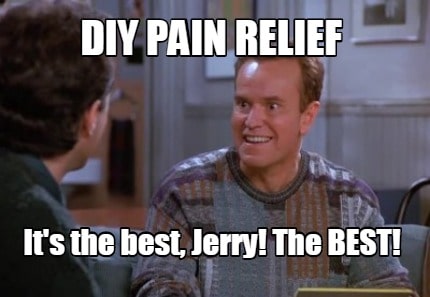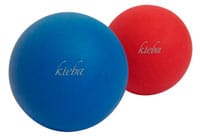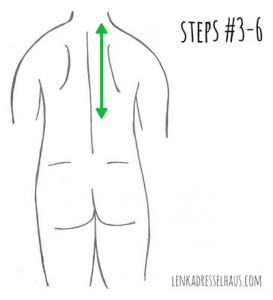This is a guest post written by Lenka Dresselhaus Restorative Massage located in Milwaukie, Oregon. More more info or to schedule an appointment, visit www.lenkadresselhaus.com.
In this 3-part series, we’ll be exploring how you can help relieve upper & mid back, shoulder & rotator cuff, and low back & hip pain with a self-care technique known as Trigger Point Therapy. All you need to start is a tennis ball, racquetball or lacrosse ball, about four feet of blank wall space, and the willingness to spend a few minutes a day working out specific areas of knotted up muscle tissue.
As a Licensed Massage Therapist, I’ve had great results over the last 14 years by using trigger point therapy to bring relief to people in pain. Most of these clients have repetitive use injuries, or are in the later phases of recovering from an acute injury and are hitting a plateau in their healing.
This is by far my favorite self-care technique to use with clients: low tech, quick, effective and empowering! How great is it to know what to do to relieve your own pain?

So what exactly are trigger points & what causes them?
“Trigger points are tiny areas of irritation that form within strained bands of muscle tissue. They refer sensations of pain, weakness, or numbness to surrounding or distant areas of muscle tissue. Trigger points are present in the majority of cases of chronic muscular pain.”
-The Balanced Body: A Guide to Deep Tissue and Neuromuscular Therapy by Donald W. Scheumann, 2002.
Causes include:
- Injury
- Repetitive movement and overuse
- Postural stress and poor body mechanics
- Exposure to cold
- Tension and stress
Disclaimer:
Please use common sense. If you have a serious medical condition such as osteoporosis, cancer, diabetes, or are on any medications that cause easy bruising, loss of sensation, dizziness, or balance issues, please don’t use this technique without your physician’s approval.

How to do trigger point self-massage:
- Get yourself a ball or two. I recommend the set on the right but the below types work fine as well.
- Racquetball = medium/firm pressure
- Tennis ball = firm pressure
- Lacrosse ball = extra firm pressure.
- Find about four feet of blank wall space.
 Back up to the wall, feet pointing straight ahead, and get down into a 5-6” squat (to protect the low back & give you the range of motion needed to work the whole mid to upper back).
Back up to the wall, feet pointing straight ahead, and get down into a 5-6” squat (to protect the low back & give you the range of motion needed to work the whole mid to upper back).- You’ll be working one side of your back at a time, so once you’re in the squat, place the ball in the area of your mid back, between your spine and shoulder blade (scapula).
- Slowly squat down until the ball reaches the top of the shoulder (traps), right before it wants to flip over.
- Then slowly stand all the way up, so the ball is now on the lower end of the mid back. It should be right at the bottom part of the lower traps. Repeat this slow movement for 30 seconds to 1 minute, warming up the area and paying attention on where it’s feeling knotted up or tender.
- Next, you’ll be doing the point work: you’ll be working 7 points over the area that you just warmed up. The first point is right where you started in step #4, between the shoulder
 blade/scapula and the spine, in the mid back. Press and hold for 3-4 breaths, with enough pressure to feel like “yep, that’s a good spot”, but not so much that you’re wincing or holding your breath (that’s actually counterproductive).
blade/scapula and the spine, in the mid back. Press and hold for 3-4 breaths, with enough pressure to feel like “yep, that’s a good spot”, but not so much that you’re wincing or holding your breath (that’s actually counterproductive). - Next, move up about an inch (by squatting down a tiny bit), and hold pressure on the next spot up. Repeat two more times, until you get to the top of the shoulder.
- Go back to the starting point to get your bearings, and this time head 1 inch down, by squatting up a tiny bit, hold for 3-4 breaths, and repeat with the next 2 points down. You may have to adjust the ball and your squat just a bit.
- That’s it! You did it! Now switch and repeat on the other side.
The idea is to work an area, give it time to flush out/recover, and then come back to it. We’re talking just 3 minutes on each area, 2-4 times a day.
Generally, if something is really bad, go for the 4 times a day–it’s worth it. If something is just kind of annoying, 2 times a day might be enough. Don’t forget to get both sides, even if only one is grumpy; you might be surprised to see what you find on your “good” side due to compensation patterns.
You should start noticing improvement within 3 days, often sooner.
Tips:
- If you find a REALLY good spot, feel free to hold it there for 30 seconds to 1 minute.
- Breathe deep into tight/stubborn spots, and watch them melt down faster. Sounds strange, but really works.
- If after working the area for a few days, you feel like you need some detail work, switch over to a super ball (the golf ball sized rubber bouncy balls that bounce way high on concrete). They can be a bit tough to find, so I send people to the Old Navy kids’ section giant gumball machines. Bring some quarters and get a few, they tend to disappear… especially if you have kids. 😉
Please do not use golf balls! They’re too hard and can actually bruise you and your walls. - When you’re done, place the ball somewhere visible to remind you to come back and work on this area some more. 3 minutes is easy to squeeze in–when waiting for something to cook, during commercials, when you’re on a phone call, etc.
Recommended:
If you’d like to get more in depth, this is my absolute favorite book on the subject: The Trigger Point Therapy Workbook

In Part 2 of the series, we’ll be going over how to use trigger point work on low back & hip pain.
Lenka
Latest posts by Lenka (see all)
- Trigger Point Therapy Self-Massage – Part 1 - July 22, 2018


 Back up to the wall, feet pointing straight ahead, and get down into a 5-6” squat (to protect the low back & give you the range of motion needed to work the whole mid to upper back).
Back up to the wall, feet pointing straight ahead, and get down into a 5-6” squat (to protect the low back & give you the range of motion needed to work the whole mid to upper back). blade/scapula and the spine, in the mid back. Press and hold for 3-4 breaths, with enough pressure to feel like “yep, that’s a good spot”, but not so much that you’re wincing or holding your breath (that’s actually counterproductive).
blade/scapula and the spine, in the mid back. Press and hold for 3-4 breaths, with enough pressure to feel like “yep, that’s a good spot”, but not so much that you’re wincing or holding your breath (that’s actually counterproductive).